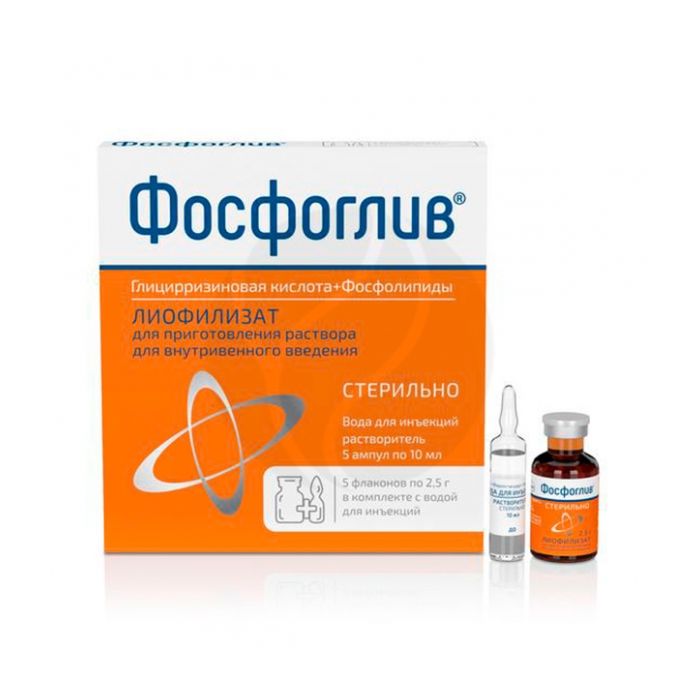Phosphogliv lyophilisate for injection 2.5 g, No. 5 + solvent 10 ml No. 5
Expiration Date: 11/2025
Russian Pharmacy name:
Фосфоглив лиофилизат для инъекций 2,5г, №5 + растворитель 10 мл №5
- viral hepatitis (acute and chronic)
- fatty liver degeneration (hepatosis)
- other liver damage (medicinal, alcoholic, toxic)
- cirrhosis of the liver
- psoriasis
Adults and children over 12 years old. Intravenously, after dissolving the lyophilisate in 10 ml of water for injection. Intravenous administration should be carried out slowly. Enter 10 ml daily, 2 times a day in the morning and in the evening for 10 days, followed by a transition to oral administration of the drug in the form of capsules. The duration of the course can be increased on the recommendation of a doctor.
One bottle contains: active substances: phospholipids (Lipoid C 100) (in terms of 100% substance) - 0.50 g, acid glycyrrhizic trisodium salt (sodium glycyrrhizinate) - 0.20 g, excipient: maltose, solvent composition for one ampoule: water for injection.
- hypersensitivity to the components of the drug
- pregnancy and lactation period
- children under 12 years old
Tradename
PhosphoglivЃ
Dosage form
Lyophilisate for preparation of solution for intravenous administration 2.5 g
Composition
One bottle contains
active substances: phospholipids (Lipoid C 100) (in terms of 100% substance) - 0.50 g, acid glycyrrhizin trisodium salt (sodium glycyrrhizinate) - 0.20 g,
excipient : maltose,
composition of the solvent for one ampoule: water for injection.
Description
Lyophilized mass from white to light yellow.
The solvent is a colorless transparent liquid, odorless and tasteless.
Pharmacotherapeutic group
Drugs for the treatment of diseases of the liver and biliary tract. Drugs for the treatment of liver diseases.
Pharmacological properties
Phosphatidylcholine (the main component of phospholipids) is the main structural element of cellular and intracellular membranes, is able to restore their structure and function in case of damage, providing a cytoprotective effect. It normalizes protein and lipid metabolism, prevents the loss of enzymes and other active substances by hepatocytes, restores liver function, inhibits the formation of connective tissue, reducing the risk of liver fibrosis and cirrhosis.
Glycyrrhizic acid has an anti-inflammatory effect, inhibits the reproduction of viruses in the liver and other organs by stimulating the production of interferons, increasing phagocytosis, and increasing the activity of natural killer cells. It has a hepatoprotective effect due to its antioxidant and membrane stabilizing activity. Glycyrrhizic acid potentiates the action of endogenous glucocorticosteroids, providing anti-inflammatory and anti-allergic effects in non-infectious liver lesions.
In case of skin lesions due to the membrane stabilizing and anti-inflammatory action, it limits the spread of the process and contributes to the regression of the disease.
Indication for use
- viral hepatitis (acute and chronic)
- fatty liver degeneration (hepatosis)
- other liver damage (medicinal, alcoholic, toxic)
- cirrhosis of the liver
- psoriasis
Method of administration and dosage
Adults and children over 12 years old. Intravenously, after dissolving the lyophilisate in 10 ml of water for injection. Intravenous administration should be carried out slowly. Enter 10 ml daily, 2 times a day in the morning and in the evening for 10 days, followed by a transition to oral administration of the drug in the form of capsules. The duration of the course can be increased on the recommendation of a doctor.
Contraindications
- hypersensitivity to the components of the drug
- pregnancy and lactation period
- children under 12 years old
Side effects
- the appearance of a skin rash (with increased individual sensitivity) is possible, which disappears after the drug is discontinued
- if the daily doses are exceeded, there may be sodium and fluid retention, edema
- increased blood pressure
- hypokalemia
When these symptoms appear, depending on their severity, it is necessary to reduce the dose of the drug and / or prescribe spironolactone 50-100 mg per day.
Drug interactions
The contents of the bottle must not be mixed with other solutions. Use only water for injection for dissolution. It is forbidden to use saline sodium chloride solution or glucose solution to dilute the drug.
special instructions
Do not inject 20 ml of the drug at the same time. The introduction of the daily dose of the drug should be carried out only in two doses, in the morning and in the evening.
Features of the effect of the drug on the ability to drive a vehicle or potentially dangerous machinery.
Not described.
Overdose
There were no cases of drug overdose.
Glycyrrhizic acid, which is part of the drug, in large doses can cause a pseudocorticosteroid effect, which is an increase in the level of glucocorticosteroids and mineralocorticoids in the blood. This leads to sodium retention and a decrease in potassium in the body and, as a result, an increase in blood pressure, water retention in the body.
Release form and packaging
2.5 g of the drug in imported medical glass vials, made of light-shielding glass, hermetically sealed with imported rubber stoppers, rolled in aluminum caps and closed with plastic safety caps or sealed with combined caps.
10 ml of solvent (water for injection) in imported ampoules made of transparent glass.
A self-adhesive label is glued to the bottle and ampoule.
5 vials of the drug complete with 5 ampoules of the solvent are placed in a blister strip packaging.
One contour package, together with instructions for medical use in the state and Russian languages, is placed in a cardboard box.
Storage conditions
In a dark place at a temperature not exceeding 25 ? C. (a drug)
At temperatures from 0 ? C to 25 ? C. Not subject to freezing (solvent).
Keep out of the reach of children!
Shelf life
2 years (drug)
4 years (solvent).
Do not use after the expiry date indicated on the package!
Conditions of dispensing from pharmacies
On prescription

